|
||||||
| Earhart Project Research Bulletin July 8, 2002 Artifact 2-6-S-45 |
||||||
|
||||||
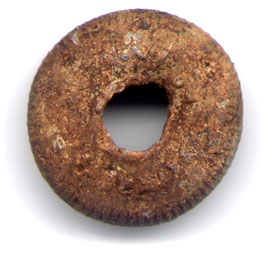
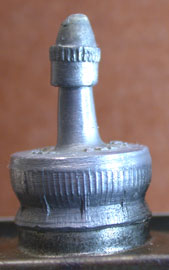 TIGHAR Artifact 2-6-S-45
has been identified. It is the “closure” portion of a type of “spout and closure”
which was patented on December 20, 1932. This type of top was used on cans
for a wide variety of products such as light lubricating oils and solvents.
Whether the artifact’s presence on Nikumaroro is attributable to the castaways
(Earhart and Noonan?), the Gilbertese colonists, Gerald Gallagher, the U.S. Coast
Guard, or someone else is unknown and probably unknowable. Nonetheless, we now
know what the thing is. We know it is not an adjustment knob from an aeronautical
navigation instrument, or a starter button from a Lockheed Electra, or any of
dozens of other speculative identities which have been considered since it was
found at the Seven Site a year ago.
TIGHAR Artifact 2-6-S-45
has been identified. It is the “closure” portion of a type of “spout and closure”
which was patented on December 20, 1932. This type of top was used on cans
for a wide variety of products such as light lubricating oils and solvents.
Whether the artifact’s presence on Nikumaroro is attributable to the castaways
(Earhart and Noonan?), the Gilbertese colonists, Gerald Gallagher, the U.S. Coast
Guard, or someone else is unknown and probably unknowable. Nonetheless, we now
know what the thing is. We know it is not an adjustment knob from an aeronautical
navigation instrument, or a starter button from a Lockheed Electra, or any of
dozens of other speculative identities which have been considered since it was
found at the Seven Site a year ago.
Artifact identification is, of course, at the heart of accurate analysis of any archeological site. The process by which we unlocked the identity of Artifact 2-6-S-45, including the mistakes we made along the way, serve as an illustration and a lesson in the methodologies that are leading us, step by step, toward the answer to the Earhart riddle.
| Lesson Number One: First Impressions Count |
When initially found by Dr. Tom King, he thought the object was a small metal cap for a container of some kind. Closer inspection, however, revealed an absence of threading, and the presence of damage around the central hole made it clear (or so we thought) that the object had once been attached to a shaft. Knurling around the edges completed the impression that what we had was a knob which originally turned a shaft which, in turn, performed some function on an instrument or device.
Our first description of the artifact was published in the November 2001 issue of TIGHAR Tracks. Ironically, our theoretical reconstruction of what the artifact originally looked like was remarkably accurate.
| TIGHAR Tracks November 2001: |
|
Weight: approx. .2 oz. Condition: Good. Bent and broken.
Speculation: This appears to be a knurled adjustment knob. There may
have been a separate, smaller concentric knob that turned a disk that
rotated within the internal channel. |
| Lesson Number Two: No Name Calling |
Because it looked like a knob we started to refer to it as “the knob,” and that was a mistake because it tended to prejudice our thinking. If it was a knob it was about the right size to be an adjustment knob for an aeronautical bubble octant and that would be very nice indeed, but we also recognized that our best avenue of investigation was the inscription cast into the surface. The problem was how to decipher it.
With the generous help of the U.S. Naval Academy’s Nondestructive Testing Laboratory in Annapolis, Maryland we were able to subject the “knob” to inspection using a Scanning Electron Microscope (SEM). Unfortunately, extreme magnification did not make the features cast into the surface any easier to read, even after cleaning with ultrasound, but the SEM did reveal the rather startling fact that the object was made of lead. In fact, that was the problem. The soft lead features had been distorted by impacts to the surface of the “knob” but it did appear that the word PATENT was present. If there was also a patent number present we should be able to make a positive identification.
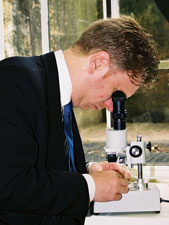 Forensic
imaging specialist Jeff Glickman at PHOTEK in Portland, Oregon next took on
the challenge of deciphering the elusive inscription.
Forensic
imaging specialist Jeff Glickman at PHOTEK in Portland, Oregon next took on
the challenge of deciphering the elusive inscription.
After trying a variety of techniques including X-ray and CT Scan he settled on precisely controlled lighting and enhanced digital photography as the best method for reconstructing the features or at least narrowing down the possibilities. Many hundreds of hours of work later he submitted his Preliminary Letter of Opinion.
Jeff Glickman examines Artifact 2-6-S-45
Among the long list of possible patent numbers were several items which were at least possibilities. The field artillery gunsight was easy to eliminate – the largest artillery that was ever on Nikumaroro was a .30 caliber machine gun at the Coast Guard Loran station – but the coincidence of the Eclipse starter was intriguing. The Lockheed Model 10E used Eclipse Type E-160 starters for its Pratt & Whitney engines. Research quickly revealed that there is nothing on an E-160 starter that looks anything like Artifact 2-6-S-45 but the starter buttons in the cockpit were the right size. The buttons, however, were shielded by a spring-loaded metal cover so old photos did not reveal what they looked like.
| And the Winning Number is … |
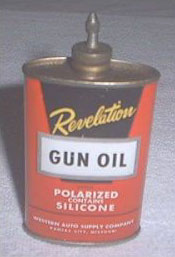 Meanwhile,
researchers on TIGHAR’s Earhart Search Forum email group were exploring
others of the 48 possibilities Jeff Glickman had identified and in early August,
Angus Murray of Sheffield, England hit paydirt when he found a collector who
had a can of “Revelation Gun Oil” which featured a spout and closure
bearing the same inscription as Artifact 2-6-S-45 right down to the colon
after the word “PATENTED”. The correct interpretation of the patent
number on the artifact is 1891826. (Photo courtesy Angus Murray.)
Meanwhile,
researchers on TIGHAR’s Earhart Search Forum email group were exploring
others of the 48 possibilities Jeff Glickman had identified and in early August,
Angus Murray of Sheffield, England hit paydirt when he found a collector who
had a can of “Revelation Gun Oil” which featured a spout and closure
bearing the same inscription as Artifact 2-6-S-45 right down to the colon
after the word “PATENTED”. The correct interpretation of the patent
number on the artifact is 1891826. (Photo courtesy Angus Murray.)
As Angus wrote to the Earhart forum:
[E]verything dropped into place. Lead is a most unusual engineering material and I can think of few examples where it might be used as a knob. As a closure however it has a number of advantages. It is easily crimped into place. It forms an effective seal at the resealable end of the spout. It will produce no sparks in a lighter-fluid refill application. … This is one application that makes complete sense. It is also easy to see how the ragged hole arises in the middle, from where the spout has been broken out.
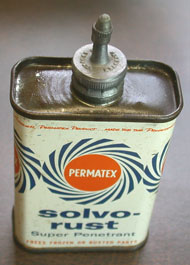 To
complete and confirm the identification process, Kenton Spading (TIGHAR #1382EC)
located a collector in Minnesota who had a can of Permatex “Solvo Rust
Oil” with the same kind of spout and closure. TIGHAR was able to purchase
the can for direct comparison to the artifact.
To
complete and confirm the identification process, Kenton Spading (TIGHAR #1382EC)
located a collector in Minnesota who had a can of Permatex “Solvo Rust
Oil” with the same kind of spout and closure. TIGHAR was able to purchase
the can for direct comparison to the artifact.
As with the gun oil can found by Angus, the spout on the rust oil can bears the same inscription and patent number as Artifact 2-6-S-45 but the shape of the cap is somewhat different.

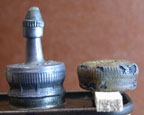 If
we were able to find an exact match we’d know what product our artifact
was associated with and that information might give us a better idea who
left it there, but gun oil, lighter fluid, and light lubricating oil are
all possibilities that could be associated with the Coast Guard, the colonists,
or even Earhart. The artifact, however, has been identified.
A question has been conclusively answered and, in archeology as in life,conclusive
answers are rare. In working our way through the identification process we
have built relationships, developed techniques, and learned lessons that
will help us identify other artifacts. The quest continues.
If
we were able to find an exact match we’d know what product our artifact
was associated with and that information might give us a better idea who
left it there, but gun oil, lighter fluid, and light lubricating oil are
all possibilities that could be associated with the Coast Guard, the colonists,
or even Earhart. The artifact, however, has been identified.
A question has been conclusively answered and, in archeology as in life,conclusive
answers are rare. In working our way through the identification process we
have built relationships, developed techniques, and learned lessons that
will help us identify other artifacts. The quest continues.

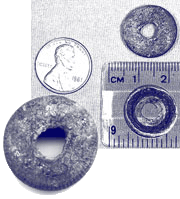 Material:
Non-magnetic silver-colored metal beneath rust-colored exterior. The
exterior edge has small grooves and there are letters (worn and, so
far, illegible) on the upper surface which may include patent information.
There is a separate internal channel around the interior surface.
Material:
Non-magnetic silver-colored metal beneath rust-colored exterior. The
exterior edge has small grooves and there are letters (worn and, so
far, illegible) on the upper surface which may include patent information.
There is a separate internal channel around the interior surface.
 This suggests a knob for making coarse and fine adjustments to some
kind of small instrument or machine. If we can decipher the letters
on the exterior surface we might be able to make a positive identification.
This suggests a knob for making coarse and fine adjustments to some
kind of small instrument or machine. If we can decipher the letters
on the exterior surface we might be able to make a positive identification.
